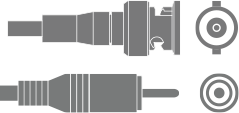Converters, distribution and scalers buyers guide
Converters are possibly the most straightforward device we can have in our signal chain. They do exactly as the say on the box by converting from one standard to another. Converters can come in all shapes and sizes with multiple models that convert to and from different formats so it’d be nearly impossible to catalogue them all. This guide is simply an overview of what to look for when purchasing a converter.

Connections
This is the most obvious are to be aware of as you want to be able to connect your source device to your converter! Whether you need to convert from SDI to HDMI or from analogue to digital, knowing what connection you need is critical.


SDI
SDI or Serial Digital Interface is the most common format in professional video. A locking BNC connector used to transmit a digital signal.

HDMI
HDMI is more common in consumer and prosumer products as it does not feature a locking connector. HDMI can however transmit a large amount of data and can even send power for certain devices.

ANALOGUE
Whilst we often think of the older RCA connections as used on older video equipment, professional equipment tends to use the same BNC connector as SDI transmission. As such it’s very important to know whether your device is outputting an analogue or digital signal from its BNCs!

FIBRE
Fibre connections can use a variety of different connectors. Often you can purchase your own SFP (Small Form-factor pluggable transceiver) which will come with a choice of connector. The important part of fibre transmission is not the connector necessarily but ensuring that the device supports the wavelength of fibre signal you are transmitting. The most common wavelength in professional video is 1310nm (nanometers).
Standards Converters/scalers
Standards converters or scalers, are slightly different to normal converters as whilst some of them will convert from one physical connection to another, their primary function is to convert the image being sent over the physical connection. There are two types of standards conversion we talk about, scaling and cross conversion.
Scaling
Scaling is the process of, you guessed it, scaling the resolution up or down and as such is also often referred to as Up or Down conversion. Rather than just stretching or compressing an image to fill the raster, most professional standards converters use complex algorithms to scale the video as accurately as possible.
Cross conversion
Cross conversion is most commonly used to describe converting between different scan types (interlaced and progressive) or between different frame rates. Like scaling professional solutions use very specialised algorithms to perform the conversions so as to avoid any stuttering or repeat frames when converting.

Distribution
Whilst distribution amplifiers or D/As (not to be confused with Digital to Analogue converters) do not usually convert, they are often considered in the same product family as converters. The idea behind a D/A simple, they take in your signal and then replicate it across multiple outputs. These devices are a great and cheap way to feed the same video to multiple destinations.

The best converters and scalers
There you have it, everything you need to know when choosing test equipment. We hope you've found this buyers guide helpful. Don't hesitate to contact one of our friendly advisors for more advice if you still have questions on how to select test equipment. If you’re all set to go we recommend checking out the test equipment from these top brands.
VIEW RANGE